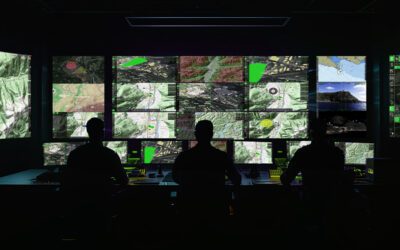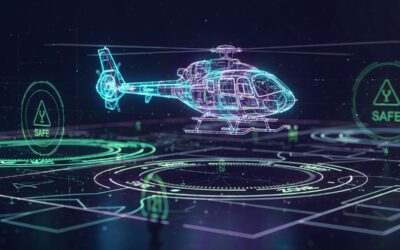With a history stretching back over 100 years, the concept of UAVs or Unmanned Aerial Vehicles isn’t new. But what has revolutionised this area of airborne activity is the development of next-generation technology and turnkey solutions that can turn a simple unmanned drone into something far more complex. Introduce the concept of UAV AI, and you open up a whole new field of activity that’s transforming everything from military operations to Search & Rescue and law enforcement operations.
In this article, we are going to take a more in-depth look at how systems such as the innovative FlySight OPENSIGHT solution power next-generation uncrewed aerial systems. We’ll look at how artificial intelligence has advanced UAV technology from manual piloting to AI-driven autonomy, along with the introduction of many more high-tech features.
Smarter and safer aerial systems
The development of embedding artificial intelligence into UAVs has been most noticeable in military applications. Initially, the purpose of AI UAVs was to provide better visual intelligence through the use of multispectral cameras, infrared sensors, and other analytical onboard tools to observe and detect enemy targets without putting human pilots at risk.
Complete autonomy for AI UAVs is a long way off, but the use of console systems that incorporate AI into crewless aerial vehicles has, without a doubt, led to smarter and safer aerial systems. In fact, the impact that AI UAVs have had on the development of modern aerial warfare cannot be underestimated. AI is redefining how drones and UAVs can be deployed, their roles in both combat and non-combat operations, and their potential to carry out procedures autonomously. But before we get too carried away, there are issues to address.
How much autonomy do we want AI UAVs to have?
This is the big question, especially for outside observers who may not fully grasp the role of drone artificial intelligence. Questions are constantly being raised about the safety and regulations governing the use of AI drones, both in military and, more controversially, in civilian roles. The question of AI ethics in UAV deployment, and in particular the boundaries and restrictions in life-or-death scenarios, is constantly debated, as is the issue of maintaining a level of human control over AI decision-making.
Obviously, fully independent AI decision-making is not an option. There must always be a human element in the final decision. But what AI can do with impunity is enhance the abilities of human operators without putting them at physical risk, as well as improve the analysis of ‘big data’, something humans can struggle with.
To this end, the growing demand for smarter and safer aerial systems, especially within the defence and emergency response sectors, has led to the development of systems such as FlySight’s revolutionary OPENSIGHT. That game-changing element is still very much in evidence, leading to greater autonomy in flight, faster automated decision-making, improved efficiency, and reduced costs. While fewer human resources are required, that human element is still very much in play – AI and, to a certain extent, Enhanced Reality are tools, not replacements. The ability to easily integrate with other advanced technologies, such as situational awareness software, sensors, and automatic target recognition, also gives AI an advantage that, in turn, provides greater operational control and ultimately mission success.
FlySight OPENSIGHT – setting the benchmark for UAV artificial intelligence
Let’s now take a closer look at how OPENSIGHT has rewritten the book on incorporating AI into UAV operations.
OPENSIGHT is a turnkey modular platform that can be integrated into legacy systems. It’s a multi-platform PED that processes, exploits, and disseminates data gathered from highly advanced multispectral cameras and other inputs.
Its purpose is to use AI and Enhanced Reality overlays to provide real-time decision-making support to operational teams in the air and on the ground. Utilising systems such as the Cloud for data collection and distribution represents a new level of expertise for mission data analysis. This leads to better and more effective decision-making in both combat and non-combat situations.
Over ten years of development have gone into OPENSIGHT, following STANAG guidelines and rules. That makes it one of the most advanced information-processing systems for airborne units, including UAVs.
What makes OPENSIGHT so different is the level of technology that goes into each part of the system.
- Sensor fusion and autonomous navigation integration – From the outset, OPENSIGHT’s developers realised that individual data packets are useless without context. So, creating the ability to fuse data from multiple sensors and to give it a location by integrating it into a navigational system provides that all-important contextual element.
- Automated decision-making – this is where AI really steps in. Through real-time mission analysis and dissemination, OPENSIGHT enables UAVs and manned operational platforms to make informed decisions. However, the activation of operational commands based on that dissemination will always be provided by a ‘human’ element, especially in life-or-death scenarios. Whether this situation changes or not in the future is open to debate.
- Assistance with target detection – Through real-time mission analysis and sensor data processing, AI in a UAV context can assist with accurate target detection, even in the presence of significant background ‘noise’. AI can filter out anything that does not fall within the mission statement’s parameters, and can also use machine learning to adapt to changing scenarios. This machine learning allows AI to focus on a target and even predict the target’s next move to a certain degree. A collaboration with automated targeting software makes this process extremely accurate, providing up-to-the-minute intelligence that can form a key part of a mission.
- Autonomous decision-making – We have previously mentioned this. While AI is perfectly capable of making autonomous decisions, the implications of a decision made by a machine rather than a human operator are fraught with issues. To this end, AI —even on the highly advanced OPENSIGHT platform —is never fully autonomous when it comes to mission-critical decision-making. It can, however, make operational decisions, such as working to a predetermined search pattern, and adapt that plan should the situation on the ground change.
AI incorporates highly sophisticated algorithms to render a map of the surroundings, avoiding obstacles such as power lines and allowing them to operate relatively independently, even when the line of sight is not available. As far as autonomous decision-making goes, this is as far as humans are willing to allow AI ‘free rein’ for now. But in the future, that may change, and AI UAVs could have far more freedom to interpret and react to their surroundings.
Uses for AI and UAVs
In tandem, UAVs and AI represent a ground shift in how military operations are carried out. But this combination of real and virtual technologies has many applications in other arenas, as OPENSIGHT is proving.
- Defence & Security – The arena for which drone artificial intelligence was originally developed, enabling crewless aerial vehicles to capture crucial data on target movements. Combined with satellite imagery and a wealth of data from various multispectral cameras, it provides a comprehensive overview and enables fast, accurate decision-making.
- Disaster Response – The sheer amount of data AI UAVs can capture in a single pass is colossal. In a disaster response situation, every piece of information matters. What AI, and in particular modular systems such as OPENSIGHT, can do is overlay documented information on a scenario that may have been irreversibly altered by a natural disaster such as an earthquake. This information could include data on the positions of gas pipelines, spectral analysis of a dam wall to spot microcracks, or identifying ‘hot spots’ in a forest fire that need the attention of ground-based teams. In disaster response, the use of AI is changing the way operational controllers respond to highly fluid situations.
- Aerial surveillance in policing – The use of drone artificial intelligence in policing and law enforcement is particularly sensitive. It has to be handled very carefully, especially in the current political climate. However, for crowd control and aerial surveillance, AI is a valuable addition to aerial units, including UAVs (which are now increasingly used by law enforcement). AI can help predict crowd dynamics, flow, and potential flash or pinch points, enabling law enforcement teams on the ground to manage crowds and maintain safety.
- Search and rescue – OPENSIGHT’s console systems have proven particularly relevant to SAR applications, allowing teams to overlay information on real-time mapping to fine-tune search patterns. This ensures that the most effective methodology is used, which, in a major life-threatening situation could make all the difference. AI technology and UAVs can assist human SAR teams, maximising efficiency while keeping costs and fatigue concerns down during long SAR events.
What could the future look like for the next generation of uncrewed aerial systems?
We have only just begun to scratch the surface with AI technology, especially in drone and UAV AI. As battery technology improves and UAVs can stay in the air longer, the potential to gather more mission-critical data increases. The ease with which systems such as OPENSIGHT can be retrofitted into legacy systems also makes it easier for more units to benefit from the inclusion of artificial intelligence.
Advances such as AI-driven swarm technology enable multiple units to operate in an interconnected way, covering larger areas (particularly relevant for SAR and disaster management and response). Swarms also have considerable applications in military operations.
OPENSIGHT is leading the way in AI and AR integration into crewless aerial vehicles. Light, easy to use, intuitive and customisable, it can be adapted for almost any situation and any scenario, including both marine and land-based missions. This ease of use – along with the fact that the next generation of operators is already relatively familiar with the concepts and operational procedures of such technology – makes it inevitable that we will see far greater use of AI drone technology in the future.
To find out more about OPENSIGHT, download our brochure or watch our videos demonstrating the capabilities and potential of this exceptional system. You can also contact us direct to discuss how OPENSIGHT could become an integral part of your operations.




